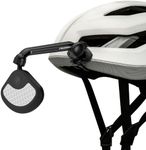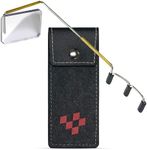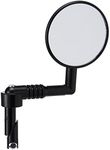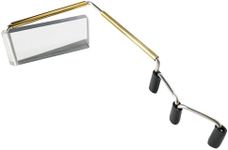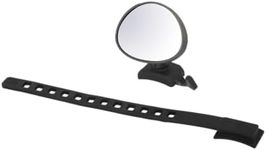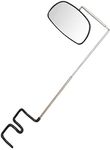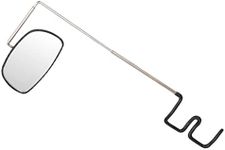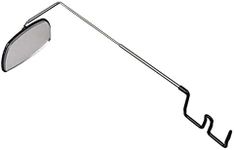Buying Guide for the Best Bike Helmet Mirrors
Choosing the right bike helmet mirror can make your rides safer and more comfortable by allowing you to see what's happening behind you without turning your head. The best mirror for you will depend on your riding style, comfort preferences, and the environments where you cycle. Understanding the key features will help you make a choice that fits your needs and enhances your cycling experience.Mirror SizeMirror size refers to the diameter or surface area of the reflective part of the helmet mirror. A larger mirror gives you a wider field of view, making it easier to spot vehicles or other cyclists behind you, but it can also be heavier and more noticeable in your peripheral vision. Smaller mirrors are lighter and less obtrusive but may require more head movement to get a full view. If you ride in busy areas or want maximum awareness, a larger mirror might be better. For minimalists or those who ride in quieter areas, a smaller mirror could be sufficient.
Mounting MechanismThe mounting mechanism is how the mirror attaches to your helmet. Some mirrors use clips, others use adhesive pads, and some have straps or Velcro. A secure and stable mount is important so the mirror doesn't shift while riding. Clip-on and strap mounts are usually more adjustable and reusable, while adhesive mounts are more permanent but can be less flexible. If you switch helmets often or want to adjust the mirror's position, look for a more adjustable mounting system. If you want a set-and-forget solution, adhesive might work best.
AdjustabilityAdjustability refers to how much you can change the angle and position of the mirror. Some mirrors have flexible arms or ball joints that let you fine-tune the view, while others are fixed in place. More adjustability allows you to customize the mirror for your height, riding posture, and helmet shape, which is especially useful if you share the helmet or change your riding position often. If you want a personalized fit or ride in different conditions, choose a mirror with a highly adjustable arm or joint.
WeightWeight is how heavy the mirror is, which can affect your comfort and the balance of your helmet. Lighter mirrors are less likely to be noticed and won't cause the helmet to shift, but they may be less durable or have smaller reflective surfaces. Heavier mirrors might offer better stability or a larger view but could feel cumbersome on long rides. If you value comfort and barely-there feel, go for a lightweight option. If you prioritize a stable, clear view, a slightly heavier mirror may be acceptable.
DurabilityDurability is about how well the mirror holds up to regular use, weather, and occasional bumps. Materials like stainless steel, high-quality plastic, or shatterproof glass can make a mirror more robust. If you ride in all weather conditions or tend to be rough on your gear, look for a mirror made from sturdy materials. If you only ride occasionally or in mild conditions, durability may be less of a concern.
Mirror ClarityMirror clarity refers to how clearly you can see objects in the reflection. High-quality mirrors provide a sharp, undistorted image, which is crucial for quickly identifying vehicles or obstacles. Some mirrors may have anti-glare coatings or be made from materials that resist fogging. If you ride in bright sunlight or humid conditions, prioritize a mirror with good clarity and anti-glare or anti-fog features. For casual rides in mild weather, basic clarity may be sufficient.
